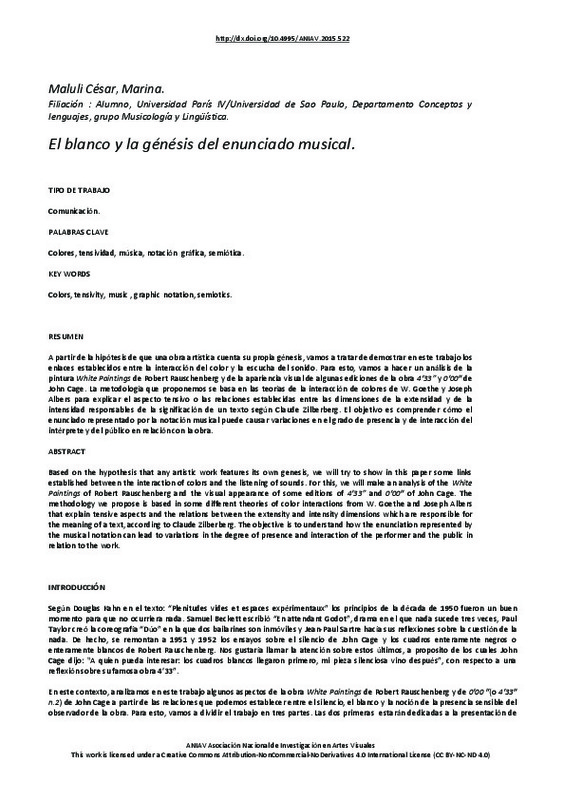JavaScript is disabled for your browser. Some features of this site may not work without it.
Buscar en RiuNet
Listar
Mi cuenta
Estadísticas
Ayuda RiuNet
Admin. UPV
El blanco y la génesis del enunciado musical
Mostrar el registro sencillo del ítem
Ficheros en el ítem
| dc.contributor.author | Maluli César, Marina
|
es_ES |
| dc.date.accessioned | 2017-10-06T07:01:28Z | |
| dc.date.available | 2017-10-06T07:01:28Z | |
| dc.date.issued | 2015-11-26 | |
| dc.identifier.isbn | 9788490483411 | |
| dc.identifier.uri | http://hdl.handle.net/10251/88884 | |
| dc.description.abstract | [EN] Based on the hypothesis that any artistic work features its own genesis, we will try to show in this paper some links established between the interaction of colors and the listening of sounds. For this, we will make an analysis of the White& Paintings& of Robert Rauschenberg and the visual appearance of some editions of 4'33” and 0'00" of John Cage. The methodology we propose is based in some different theories of color interactions from W. Goethe and Joseph Albers that explain tensive aspects and the relations between the extensity and intensity dimensions which are responsible for the meaning of a text, according to Claude Zilberberg. The objective is to understand how the enunciation represented by the musical notation can lead to variations in the degree of presence and interaction of the performer and the public in relation to the work. | es_ES |
| dc.description.abstract | [ES] A partir de la hipótesis de que una obra artística cuenta su propia génesis, vamos a tratar de demostrar en este trabajo los enlaces establecidos entre la interacción del color y la escucha del sonido. Para esto, vamos a hacer un análisis de la pintura White Paintings de Robert Rauschenberg y de la apariencia visual de algunas ediciones de la obra 4'33 y 0'00" de John Cage. La metodología que proponemos se basa en las teorías de la interacción de colores de W. Goethe y Joseph Albers para explicar el aspecto tensivo o las relaciones establecidas entre las dimensiones de la extensidad y de la intensidad responsables de la significación de un texto según Claude Zilberberg. El objetivo es comprender cómo el enunciado representado por la notación musical puede causar variaciones en el grado de presencia y de interacción del intérprete y del público en relación con la obra. | es_ES |
| dc.format.extent | 7 | es_ES |
| dc.language | Español | es_ES |
| dc.publisher | Editorial Universitat Politècnica de València | es_ES |
| dc.relation.ispartof | II CONGRESO INTERNACIONAL DE INVESTIGACIÓN EN ARTE VISUALES | es_ES |
| dc.rights | Reconocimiento - No comercial - Sin obra derivada (by-nc-nd) | es_ES |
| dc.subject | Arte | es_ES |
| dc.subject | Producción artística | es_ES |
| dc.subject | Estética | es_ES |
| dc.subject | Teoría del Arte | es_ES |
| dc.subject | Gestión cultural | es_ES |
| dc.subject | Educación artística | es_ES |
| dc.subject | Investigación artística | es_ES |
| dc.title | El blanco y la génesis del enunciado musical | es_ES |
| dc.type | Capítulo de libro | es_ES |
| dc.type | Comunicación en congreso | es_ES |
| dc.identifier.doi | 10.4995/ANIAV2015.522 | |
| dc.rights.accessRights | Abierto | es_ES |
| dc.description.bibliographicCitation | Maluli César, M. (2015). El blanco y la génesis del enunciado musical. En II CONGRESO INTERNACIONAL DE INVESTIGACIÓN EN ARTE VISUALES. Editorial Universitat Politècnica de València. 415-421. https://doi.org/10.4995/ANIAV2015.522 | es_ES |
| dc.description.accrualMethod | OCS | es_ES |
| dc.relation.conferencename | II Congreso Internacional de Investigación en Artes Visuales. |< real | virtual >| ANIAV2015 | es_ES |
| dc.relation.conferencedate | July 09-10,2015 | es_ES |
| dc.relation.conferenceplace | Valencia, Spain | es_ES |
| dc.relation.publisherversion | http://ocs.editorial.upv.es/index.php/ANIAV/ANIAV2015/paper/view/522 | es_ES |
| dc.description.upvformatpinicio | 415 | es_ES |
| dc.description.upvformatpfin | 421 | es_ES |
| dc.type.version | info:eu-repo/semantics/publishedVersion | es_ES |
| dc.relation.pasarela | OCS\522 | es_ES |








